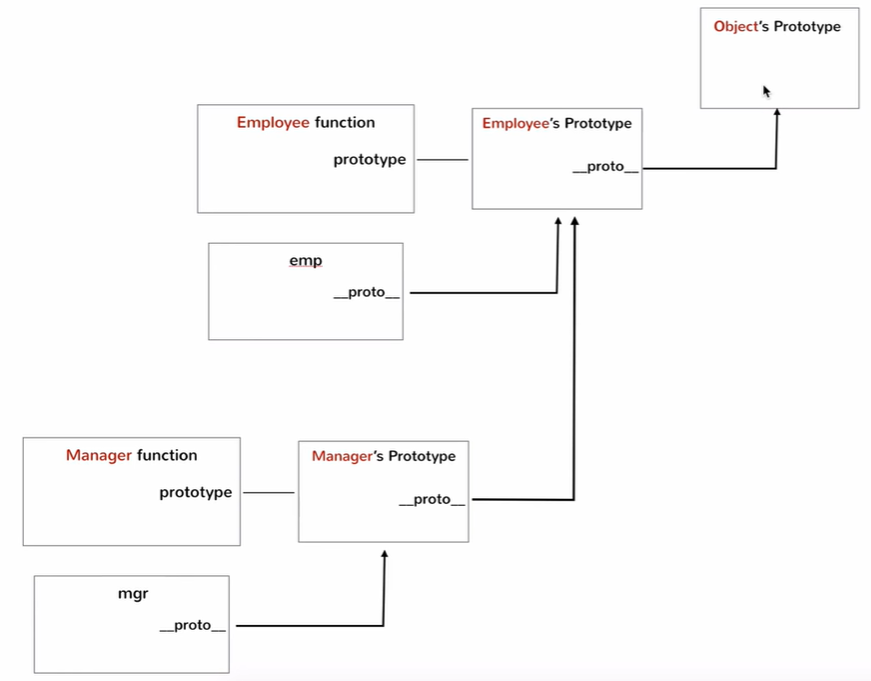Table of contents
Javascript
- javascript is a Synchronous, single-threaded language.
- JS is a lightweight, interpreted, object-oriented scripting language for web-pages.
- lightweight - small memory footprint, easy to implement.
- interpreted - no compilation, instructions are executed directly as opposed to java where intermediate bytecode is compiled and then executed.
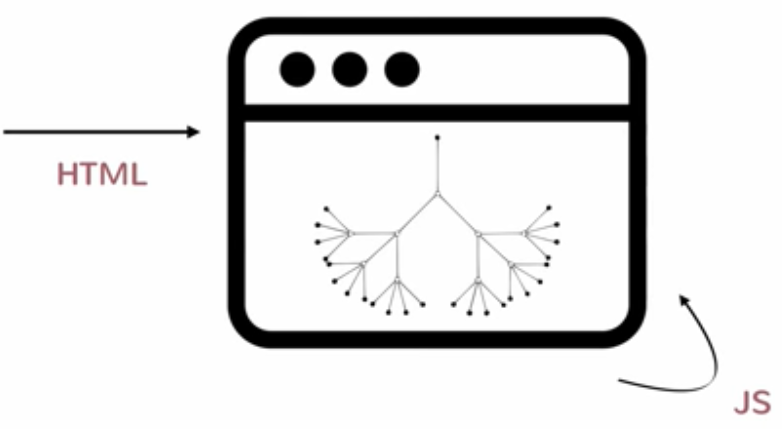
- Browser receives html as a string and constructs a DOM tree from it. This conversion will always result in same output.
- JS is used to provide dynamic functionality to this.
Use Cases for Learning JS
- Client side web development - native javascript, jQuery, AgularJS, React, Ember
- Server side development - NodeJS, Express
- Browser Extensions
- Desktop applications
- Mobile applications
- IOT applications
Execution Context
- Execution Context.
- Execution Context has 2 components
- Memory Component (Variable Enviroment) - variable and function stored as key-value pairs.
- Code Component (Thread of Execution) - js code is executed here.
How JS code is executed by JS Engine
- When you run a JS code, Global execution context is created.
- This Global Execution Context is created in 2 phases
- Memory Creation Phase - Allocates memory to variables and functions.
- variables - assigned
undefined - functions - whole function code is assigned
- variables - assigned
- Code Execution Phase - actual values are assigned to variables and functions are invoked.
- Memory Creation Phase - Allocates memory to variables and functions.
- Each function invocation creates a new Execution Context and with return statement that execution context is destroyed.
Call Stack
- Maintains the Order of Execution for Execution Contexts.
- Manages Global Execution Context and child execution context.
- Global Execution Context <= EC1 <= EC2 (top-of-stack)
- Also known as
- Call Stack
- Execution Context Stack
- Program Stack
- Control Stack
- Runtime Stack
- Machine Stack
Hoisting
- All the variables and functions defined in the js are created during memory allocation phase.
- vars as undefined
- functions as copied code block
- Functions defines as arrow function or var are allocated as if they are vars ie. undefined.
not-defined vs undefined
- not defined - means variable/function was not defined in Memory Creation Phase
- undefined - means variable/function was defined in Memory Creation phase but value is not assigned.
Shortest JS Program
- Empty js file is the shortest js program.
- JS Engine creates the following
- Global Execution Context
- Global Object -
windowfor browsers - this - pointed to window
- same :
this.a,window.a,a
Types and Variables
- Primitive Types for js
- number
- string
- booleans
- undefined
- null
- symbol - similar to enumeration (introduced in ES6)
- Type Wrapper Objects
- String
- Number
- Boolean
- Symbol
var value; // Declaration // here, value = undefined
value = 42; // Definition
console.log(typeof value);
- No types info is attached with variables in js, loosely typed language.
- same variable can be assigned values of different types
- No scoping info in variable declaration as opposed to java (private, public, static etc.)
- variables type can be interrogated - typeof
Type Coercion and === operator
- Type Coercion - Type casting
- == operator - check for equals
- === operator
- check for equals as well as type match
- precise checks
var a = 10;
var b = "10";
console.log(a == b); // true
console.log(a === b); // false
if (a) {
console.log("a is true");
}
Variable evaluation for if condition
- int - zero, means false
- string - empty, means false
- undefined - false
- null - false
This means every primitive type has a boolean type associated with it, coercion.
undefined vs null
- undefined
- it is a variable type as well.
- value has never been initialized (untouched form field)
- null - value was assigned but not a proper value (visited form field)
- you can set an object property as null to convey that property name is valid but currently no value is set.
Objects
- Objects are of free form as js doesn’t have concept of classes.
- No strict structure of objects.
- In js, objects behave as key-value pair like a map.
- Object literal notion to create objects.
- Object properties can be accessed directly.
- New properties can be added to objects directly.
- Objects can have methods.
var myObj = {};
console.log(myObj);
myObject.name = "Arpit Tripathi";
Dot and [ ] Notation
- Object properties can be accessed by dot notation or square bracket notation.
- Used when property name is
- a reserved word or invalid identifier.
- starts with a number.
- dynamic
- returns value or undefined
- Runtime engine may not be able to optimize [] notation.
- Dot and [] notations can be interchanged.
var myObject = {
"name":"Arpit Tripathi",
"1":"One"
"address":{
"state" : "Maharashtra",
"country": "India"
}
};
console.log(myObj.name);
console.log(myObj["name"]);
console.log(myObj.1); // Dot operator will fail due invalid identifier
console.log(myObj["1"]); // So, we use square bracket identifier
var propertyName = "dynamicProperty";
console.log(myObj[propertyName]); // Dynamic Property Name
console.log(myObj.address.country); // accessing internal proerty
Deleting a property
delete myObj["1"];
console.log(myObj);
JSON vs JS Object
Difference Between JSON Object and JavaScript Object
- JSON stands for JavaScript Object Notation.
- JSON is a lightweight data interchange format.
- Human readable, Easy to parse, Lightweight
- JSON is plain text that we use to transfer data.
- JSON is not specific to JavaScript. can parse a JSON string using any other programming language, like PHP, .Net, Pearl.
- Unlike JavaScript Object, a JSON Object has to be fed into a variable as a String and then parsed into JavaScript.
- For JSON, keys can also be any valid string.
- The JSON values can only be one of the six datatypes (strings, numbers, objects, arrays, Boolean, null). JavaScript values on the other hand can be any valid JavaScript Structure.
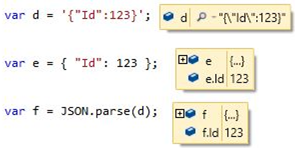
- d is JSON string
- e is JavaScript Object
- f is also a JavaScript Object, we just parse a JSON string into a JavaScript Object.
- d and e both look the same. So most developers feel that d is a JSON object.
| JSON | JS Object |
|---|---|
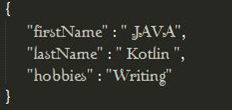 | 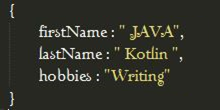 |
Global Objects
Mathis a Global object provided in js.Datewindow
Constructor
function createEmployeeObject(fname, lname, gender, designation) {
var newObject = {};
newObject.fname = fname;
newObject.lname = lname;
newObject.gender = gender;
newObject.designation = designation;
return newObject;
}
var emp1 = createEmployeeObject("Arpit", "Tripathi", "M", "Developer");
var emp2 = new Employee("Arpit", "Tripathi", "M", "Developer");
function Employee(fname, lname, gender, designation) {
this.fname = fname;
this.lname = lname;
this.gender = gender;
this.designation = designation;
}
Arrays
- Arrays are not homogeneous due to free form.
- 0 based indexing
- undefined for out of bound index.
- js array is underneath a js object with a property length.
- property names are numbers - 0,1,2…
- arr[3] is internally converted to arr[“3”] for square bracket notation.
var arr = [100, 200, 300];
arr[3] = 400;
arr.length;
var arr = [10, 20, "hello", {}]; // Valid Declaration
Array Methods
var arr = [10,20,'Hello',{}];
arr.push(50); // adds at end
arr.pop(); // removes from end
arr.splice(index,1); // find index and removes 1 element
arr.shift(); // removes from front
arr.unshift(42); // adds at front
var myFunction = fucntion(item, index, array){ // 3 parameters passed by forEach
console.log("For each element "+item);
};
arr.forEach(myFunction);
Functions
- free form language, hence method overloading is not possible.
- flexible argument counts.
- In JS, functions are values.
// Function Declaration
function sayHello(name, surname) {
// No need to declare type as everything is var
console.log("Hello " + name + " " + surname);
}
sayHello("Arpit", "Tripathi");
sayHello("Arpit"); // no compilation error, surname will be undefined
sayHello("Arpit", "Tripathi", "India"); // No compilation error, 3rd argument is ignored
var value = ("Arpit", "Tripathi"); // returns undefined
function sayHello(name, surname) {
return "Hello " + name + " " + surname;
}
Function Expression and Anonymous Function Expression
// Function Expression - Note ';' at end of function
var hello = function sayHello(name, surname) {
console.log("Hello " + name + " " + surname);
};
hello("Arpit", "Tripathi");
// Anonymous Function Expression
var hello = function sayHello(name, surname) {
console.log("Hello " + name + " " + surname);
};
hello("Arpit", "Tripathi");
Function as Argument
// Passing function as argument
var executor = function (fn) {
fn();
};
executor(hello);
Function as Object Property
var myObj = {
propa: "hello",
};
myObj.myMethod = function () {
console.log("Method in object property");
};
myObj.myMethod();
this Keyword
var person = {
firstName: "Arpit",
lastName: "Arpit",
getFullname: function () {
return person.firstName + person.lastName;
}, // called when function execution is initiated
};
var fullName = person.getFullname();
console.log(fullName);
var person2 = person;
person = {};
fullName = person2.getFullname(); // here getFullname is constructed from person rather than person2
var person = {
firstName: "Arpit",
lastName: "Arpit",
getFullname: function () {
return this.firstName + this.lastName;
},
};
foo(); // 'this' will refer to global object
obj.foo(); // 'this' will refer to obj
new foo(); // 'this' will refer to newly created object
foo.call(myObj); // 'this' will refer to myObj
Default Function Arguments
- we get 2 properties -
argumentsandthis - arguments value is not an array, we use it as array but it is an object.
var add = fucntion(a,b){
console.log(arguments); // captures full list of passed arguments
return (a+b);
}
add(2,3);
add(2,3,4,5,6);
var add = fucntion(){
console.log(arguments); // captures full list of passed arguments
var i, sum = 0;
for(i=0; i<arguments.length, i++){
sum += arguments[i];
}
return sum;
}
Scopes
- javascript is not block-scoped, it is function-scoped
var name = "Arpit";
if (name == "Arpit") {
var surname = "Tripathi";
}
console.log(name + " " + surname);
function validate() {
if (name == "Arpit") {
// accessing parent scoped var
var surname = "Tripathi";
}
}
validate();
console.log(name + " " + surname); // runtime error, js is function scoped but we are trying to access child scoped var
- Global scoped vars are created in one master global object.
- for browser, it is
windowwhere we can see all the global objects registered. - console object is also available in this
- for browser, it is
Scope Chains
Immediately Invoked Function Expression (IIFE)
Why avoid Global variables
- Generally, multiple js files are loaded at a time and they share same namespace. Hence, global variables will be overridden.
- Same goes for function names.
// IIFE - No global funtion defined, but invoked once
(function () {
var a = 40;
var b = 60;
console.log(a + b);
})();
Compilation and Interpretation
Compilation Phase
- web browser loads and compiles the source js file, not compiled to some intermediate file.
- Here, we register variables as per the scope.
- This phase is executed very quickly.
Interpretation Phase
- Executes based on variables registered during compilation phase.
var a = 10;
function myFn() {
var b = a;
console.log(b);
c = 100;
// creates variable in global scope rather than myFn scope as it already looked upto Global scope
// solution - use var to create myFn scoped variables
}
myFn();
Due to these separate steps of compilation and interpretation, order of vars in same scope doesn’t affect anything. (example below)
var a = 10;
function outer() {
var b = a;
console.log(b);
function inner() {
var c = b; // Here, b is expected to be 10 from the global scope. but it will be undefined due to function scope.
console.log(c);
var b = 20;
}
inner();
}
outer();
console.log(a);
var a = 10;
Hoisting
- Declarartion of vars and functions are hoisted to the top of their scope while execution stays in sequence of code.
function funcA() {
funcB();
}
function funcB() {
funcA();
}
// Here hoisting is important as funcB is defined after funcA, but funcA calls funcB.
Strict Mode
- Introduced in ES5 (Ecma Script).
- ES is a standardization for JS to be implemented by clients.
"use strict;"
var myName = "Arpit";
myname = "Arpit Tripathi"; // here another global scoped var is created
("use strict;");
var myName = "Arpit";
myname = "Arpit Tripathi";
// Error : reference to undeclared variable
Closures
- function declaration keeps a snapshot of scope as well ie. it points to same variables as inside the function.
- Closure is a function that remembers scope during the time of declaration, even if it is executed from a different scope.
- Closures are useful in callbacks and creating modules.
var a = 10; // global scoped var
function outer() {
var b = 20; // function scoped var
var inner = function () {
a++;
b++;
console.log(a);
console.log(b);
};
return inner;
}
var b = 50;
var innerFn = outer(); // new copy of var b created in function
innerFn(); // prints 11 and 21 due to closures
var innerFn2 = outer();
innerFn2(); // prints 12 and 21 due to closures
Callback
var a = 10;
fucntion fn(){
console.log(a);
}
setTimeout(fn, 1000); // Here, closure has the var a definition even when passed to 3rd party function
console.log("Done!"); // Print done and then a
Module Pattern
function person(fname, lname) {
var firstName = fname;
var lastName = lname;
var returnObj = {
getFirstName: function () {
return firstName;
},
getLastName: function () {
return lastName;
},
setFirstName: function (name) {
firstName = name;
},
setLastName: function (name) {
lastName = name;
},
};
return returnObj;
}
var p = person("Arpit", "Tripathi");
console.log(p.getFirstName()); // var firstName accessed by closures
console.log(p.firstName); // undefined, property was not included in returned object
Closure in Async Callbacks
var i;
var print = function () {
console.log(i);
};
for (i = 0; i < 10; i++) {
print(); // print 0 to 9
}
for (i = 0; i < 10; i++) {
setTimeout(print, 1000); // print 10 for 10 times, all are pointing to same i
// IIFE
(function (curr) {
setTimeout(function () {
console.log(curr);
}, 1000);
})(i);
}
Prototype
- Objects created from same function shares same prototype.
- Prototype is used to define behaviors for similar objects.
- you can add properties to prototype on runtime, different from classes in Java where all behaviors are needs to be defined upfront.
function foo() {}
foo.prototype; // points to prototype object of foo
foo.prototype.constructor; // points to foo
var myObj = new foo();
// myObj has __proto__ pointing to prototype object of foo function
myObj.hello; // check myObj for property and if not found, check prototype object for property
Objectis a global function which also have a prototype.
var simple = {};
var myObj = new Object();
console.log(Object.prototype === myObj.__proto__);
// both var are constructed from Object prototype
var f = new foo(); // foo prototype has __proto__ for Object prototype
console.log(Object.prototype === f.__proto__.__proto__);
- prototypes can be used to implement inheritance in js.

